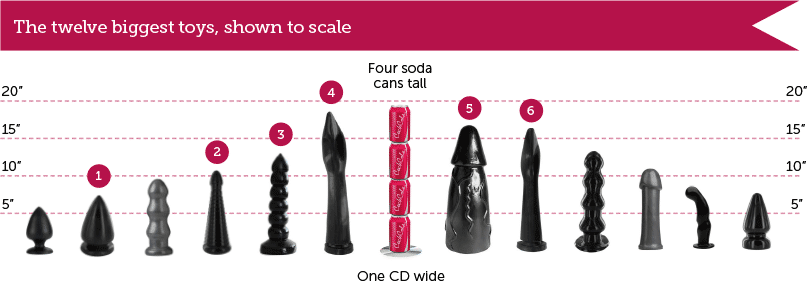
Published September 8, 2014
Down the Rabbit Hole: What One Million Sex Toy Sales Reveal About Our Erotic Tastes, Kinks and Desires
If you could take a sneaky peek into the naughty bedside drawers of 300,000 people, what would you see and what might it say about their sexual psychology?
For the very first time, the sales of one million sex toys and 45,000 of their reviews have been analysed to reveal what we do in our most intimate and uninhibited moments.
Follow the Pink Rabbit
There are two main barriers to learning about people’s sex lives. The first is finding men and women who are willing to divulge facts about the most private thing they do. The second is relying on those people to tell the whole horny truth, in all its colourful, unadulterated glory, with nothing left lying on the bedroom floor.
After all, even the most unabashed research participant could be forgiven for omitting certain details from his responses, like the recent purchase of a butt plug that is as thick as a fire extinguisher, or how the first sexual use of a speculum went down with his wife. These are intrinsically private facts and most people are understandably not keen on sharing them with strangers.
But what if you could circumvent the awkwardness of brazenly asking people what gets them off by instead analysing the objects and outfits they use to do it? In other words, use sex toys as a window into their sex lives. It’d be like finding out about people’s diets by looking at the contents of their kitchen cupboards, except in this case the cupboards are naughty bedside drawers and what’s inside them is a lot more interesting than food and drink.
This was the opportunity I was given several months ago by Lovehoney.co.uk, the U.K.’s number one retailer of sex toys and erotic gifts. They asked what insights I thought I could discover hiding in their data. I said I had no idea, but that I’d love to find out.
Lovehoney’s warehouse, situated at their head office in Bath, Somerset, is an Aladdin’s cave of colourful and crazy objects. You’ve got your bread and butter: lubes, vibrators, lingerie. Hundreds of varieties of each. But then there are the more unusual artefacts: the Fuck Me Silly Mega Masturbator[+], the 12 Inch Fist of Adonis[+], the Master Series Four Stage Rocket Dildo[+]. As I walked up and down the warehouse aisles, I marvelled at the myriad ways we humans stimulate and simulate our bodies. The collage below shows every single item Lovehoney sells. 5,508 objects, each one designed to cater for a slightly different kink or desire in the person who will eventually come to use it (and use it to come).
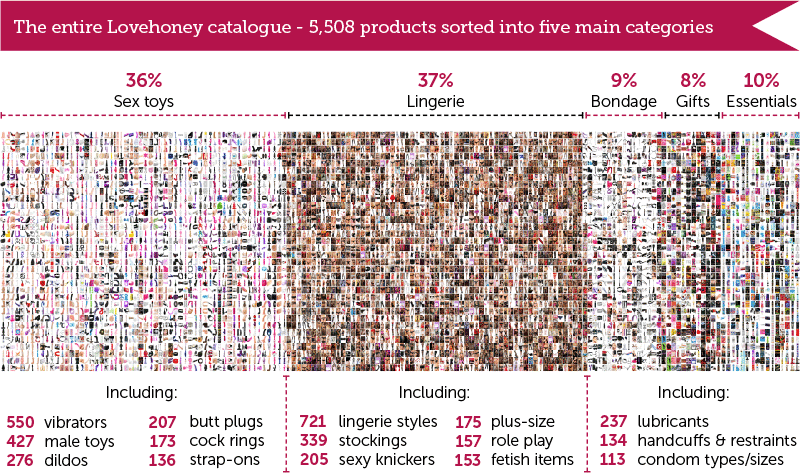
Viewing Lovehoney’s stock all at once made me realise just how many adult products there are. And when they gave me access to their Google Analytics account, I saw the incredible amount of them they sell. Since Analytics began tracking their sales in 2004, 4.5 million transactions have been processed, comprising more than 11 million individual items. And in the last 12 months alone, there have been 850,000 orders placed by UK visitors made up of 2 million items. That’s an average of four products sold every minute of every day for the entire year, each with the hope that it will in some small or big way live up to Lovehoney’s mission of improving the sexual happiness of its buyer.
Another way of expressing the sheer volume of items that leaves Lovehoney’s warehouse is with some back-of-the-envelope calculations. For example, Lovehoney has dispatched about 120,000 cock rings in the last 12 months. If these were combined into one Godzilla-sized cock ring, it could (with the necessary permit) encircle the Empire State Building twenty times.
Lovehoney sells enough lube in a year to replace all the water used in the average four-person family home for two months.
And if a truck-load of lube was required to make this grand demonstration easier, Lovehoney could supply it. They sell enough lubricant in a year to replace all the water used in the average four-person family home for two months (27,000 litres). Or, alternatively, provide a single continuous 52-hour-long lube power shower.
They sell a hell of a lot of batteries too—enough in a year to power one Jessica Rabbit 2.0 (their bestselling rabbit vibrator) for 15 million minutes, which equates to 250,000 hours, or just over 28 years. So, if the average woman takes five minutes to achieve climax using a Jessica Rabbit 2.0, then all the batteries sold in a year by Lovehoney have the potential to aid three million orgasms. Not bad.
See if you can find the Jessica Rabbit 2.0 in the spiral below. It showcases every vibrator, dildo, butt plug and set of anal beads they sell, sorted by colour and shown to scale. Think of it as a special game of Where’s Wally? (or Where’s Wabbit?).
If you’d like to see a higher resolution version of the spiral, or the massive infographic that summarises all of this study’s results, they’re available at the bottom of this page.
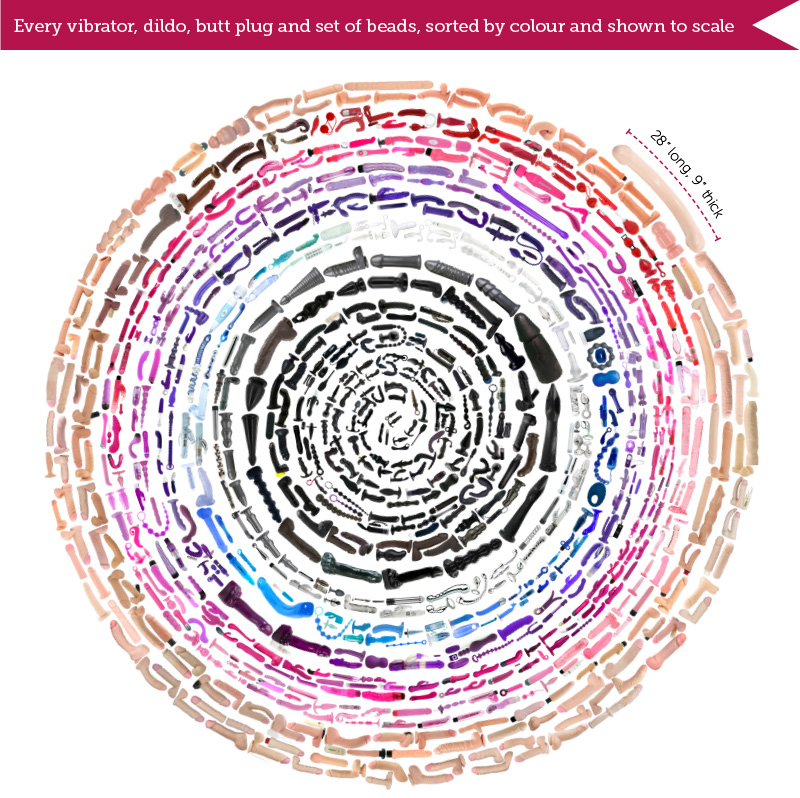
When I mentioned butt plugs as thick as fire extinguishers earlier, I wasn’t kidding. The big black monster on the inner right side of the spiral above is called Super Victor Giant Black Dildo. It weighs over 5.5 kilos, costs almost a hundred pounds, has a total length of 17 inches and a circumference of 19 inches. Here’s a photo of Lisa, one of Lovehoney TV’s presenters, demonstrating the product. Or describing it, I should say. When I lifted it up during my visit to the warehouse, it felt like an artillery shell—impossibly, comically big. But, as we’ll see later, some people can accommodate it.
Speaking of great lengths, if you laid every butt plug, dildo and vibrator sold in 12 months end-to-end, they’d stretch from Lovehoney’s warehouse in Bath all the way to Gloucester, which is 36 miles away as the dildo lies.
These calculations, although fun, are really just different ways of saying the same thing: a lot of people buy vibrators, cock rings, lubricant and other adult products and, given that they’re the number one seller of them, Lovehoney sends a lot out. But if you want to discover why people buy these objects and how they feel about them, you have to move beyond the back of an envelope.
Hard Data
The main dataset I used to derive the results you’ll see throughout the rest of this article and in its accompanying infographic comprised 1 million individual items sold over a five-month period in mid to late 2013. These 1 million items were dispatched as 420,000 orders (an average of 2.5 items per order) to roughly 300,000 different men and women around the country and world. Every row in the spreadsheet detailed one item and everything about it: its name, category, sub-category, price, size, colour, the time and date it was purchased, delivery type, whether it was returned, and so on. And each item was connected to the other items it was bought with by an order number and to its buyer with a customer ID.
Knowing everything about the objects was great, but without some demographic information on the people who bought them, the analysis wasn’t going to be very insightful. The data I was given was completely anonymised before it reached me, meaning the only things I knew about each customer were what they bought, the order-related metrics detailed above and—crucially—their first name (last names were removed).
To enrich the data, 300,000 customers’ genders were determined by analysing their first names.
So, to enrich the dataset with the first vital piece of demographic information, I needed to infer whether customers were male or female based on their first names. I did this using a lookup table of 100,000 names whose most common genders are already known. So if ‘James’ ordered a Fuck Me Silly Mega Masturbator, he was coded as a male. If ‘Rachel’ bought a Jessica Rabbit 2.0, she was coded as a female. And if ‘Kim’ ordered a large gimp mask, he/she was coded as a sexual deviant.
Just kidding. He/she was coded as an unknown, because ‘Kim’ and many other first names can be used by either sex.
This process assigned genders to 89% of the 300,000 customers in the dataset. I then hand-coded 10,000 of the unknown names to bring the figure up to 92%—in other words, nine out of ten customers now had genders assigned to their customer IDs and orders.
To make sure the process was accurate, I turned to Lovehoney’s community members—a population of 60,000 men and women who review sex toys and discuss their sex lives in Lovehoney’s online forum. These accounts have user-submitted information about their owners, like their actual genders, marital statuses and sexual orientations. By comparing my inferred genders to community members’ actual genders, I determined that 95% of my coding attempts were accurate and that the miscoded 5% were split pretty evenly between men and women.
At this stage, I was ready to answer the first and simplest question on my list of more than a hundred. Which gender is responsible for buying most sex toys? The answer is neither. Lovehoney’s customer base is harmoniously split 50/50 between men and women.
That doesn’t, however, mean that men and women buy the same things…
What Every Body Wants
The average Lovehoney customer spends a little over six minutes perusing ten pages of the site. When they place an order, they spend £35 (£14 on each item in their basket). Men on average spend £5.73 (19%) more per order than women. These figures don’t include shipping costs, because delivery is free, although 1 in 5 customers chooses to pay extra for next day delivery. Men are a bit keener than women to get their packages the following day: 23% of male customers choose the speedy option, compared to 19% of women.
About 40% of customers include instructions with their orders in case they aren’t at home to receive them, and 18.5% of those notes direct the postman to leave the goods at the house or flat next door. This seems like an excellent endorsement of Lovehoney’s discreet packaging, or possibly a sign that a significant number of their customers are having a whale of a time with their neighbours. I’m sure it’s the former.
The 5,500+ products Lovehoney sells are sorted into forty parent categories, which are further divided into 220 sub-categories. The Vibrators parent category, for example, contains rabbit vibrators, butterfly vibrators, clitoral vibrators, and so on.
It turns out that 83% of items bought from Lovehoney belong to just ten of the forty parent categories. These are the most commonly purchased types of products—the things the majority of customers want in their sex lives.
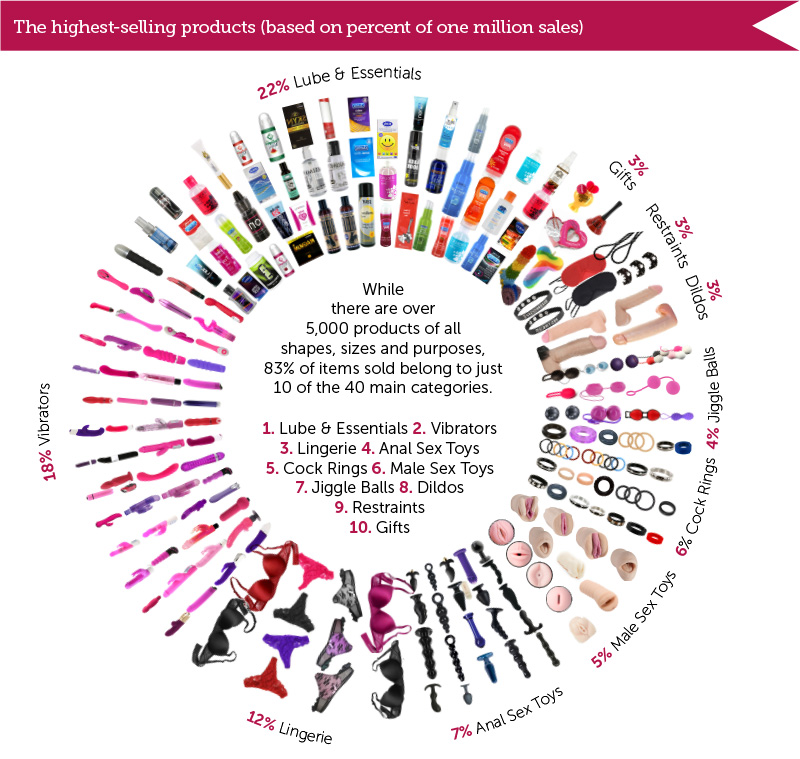
Each of the ten bestselling product types serves a different physical or psychological purpose. And each could be said to strike its own balance between stimulation and simulation. Vibrators—ostensibly female-centric sex toys—are mostly about stimulation. Half of women and one-third of men who place an order with Lovehoney buy a vibrator.
1 in 5 men buys a male sex toy, compared to 1 in 20 women.
A vibrator’s form follows its function. A rabbit vibrator, for example, has swirling pearl-filled shafts and buzzing ears that are expressly designed to stimulate the user in just the right way. Male sex toys tend to be a bit different. They are bought by 1 in 5 men but only 1 in 20 women and are more likely to be simulacrums of real body parts, like women’s pussies, asses and mouths. They’re intended to stimulate too of course, but the simulation of real sex is at the core of their design.
Then there are the products that can’t easily be classified as ‘male’ or ‘female’, like anal sex toys. These are objects whose appeal is trickiest to define and to many people, especially those who have never experimented with anal play, the point of them is hard to grasp. Are they for physical or psychological pleasure? Are they only for women (like in porn?) or just for gay men (to match the stereotype)?
In talking to people about this project, many reacted to the concept of butt plugs in the same way a 65-year-old might respond to hearing dubstep for the first time. They understand it exists, they acknowledge that it’s very popular, but they just don’t ‘get it’.
If we drill deeper into the data, we might be able to understand more about anal sex toys and other products in the sex toy spectrum.
Here is how the one million purchases were split between male and female customers. This graph alone seems to reveal a lot about the differences between male and female sexual psychology. To see what I mean, enlarge the image and scan your eyes across the various product sub-categories, noticing whether they fall into the male– or female-dominated portions of the wheel. I found many surprises hiding in there, mostly on the men’s side.
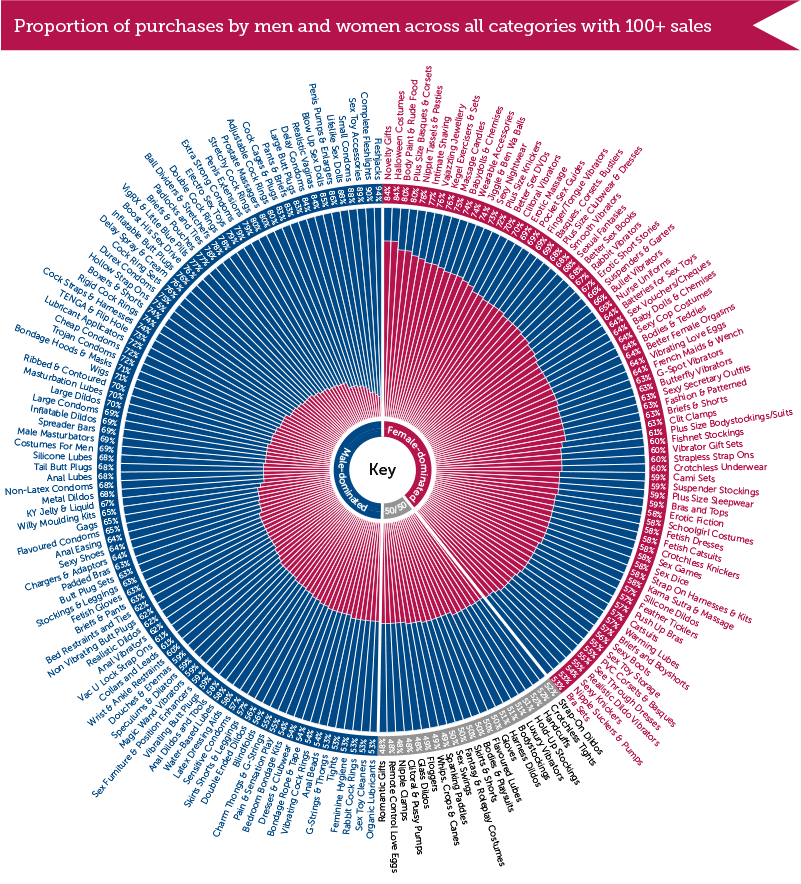
If we look at the extreme ends of the graph (at the top), we can see that the most female-dominated category (i.e., the type of product most bought by women compared to men) is Novelty Gifts. This category includes items like the Husband Voodoo Doll[+], Fetish IOU Cards[+] and the Fuck Off Eye Mask Blindfold[+].
Half of the female-dominated categories are types of clothing, compared to 12.5% of the men’s, and when outfits and lingerie are plus-size, they tend to be more female-dominated. For example, 55% of corsets are bought by women, but that figure rises to 80% when the corsets are plus-size. The same principle applies to clubwear, which is a female-dominated category in plus-sizes, but male-dominated in non-plus sizes. Perhaps women are more inclined to purchase their own sexy outfits when they require them in larger sizes, as opposed to asking their male partners to place orders on their behalf.
 The most male-dominated product types are those which you can only reasonably imagine most men using while alone—the sex simulation devices. Fleshjacks[+] and Fleshlights[+] are the most male-dominated products.
The most male-dominated product types are those which you can only reasonably imagine most men using while alone—the sex simulation devices. Fleshjacks[+] and Fleshlights[+] are the most male-dominated products.
These are male toys designed with penetration in mind that look and feel as much like real vaginas, asses and mouths as possible. There’s even a sub-range moulded from the body parts of real porn stars and these account for 1 in 3 Fleshlight sales.
Below is a graph showing Lovehoney’s sales of porn star Fleshlights, with Stoya’s accounting for an impressive 34%. Stoya and several of the other performers featured are no longer actively starring in porn, but their Fleshlights continue to sell in large numbers.
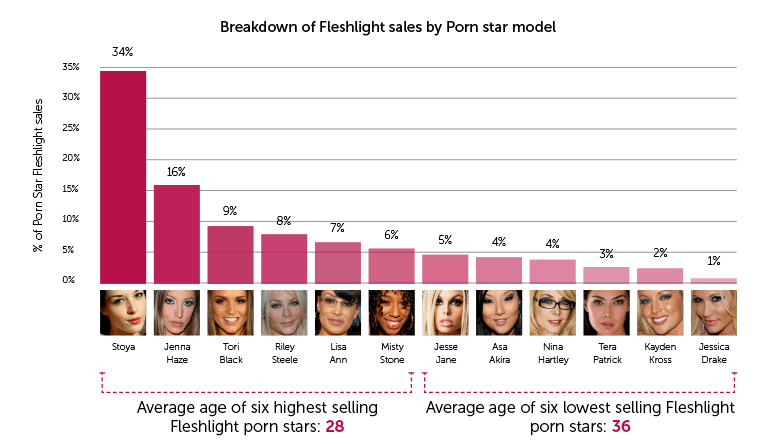
There are also a few surprises in the male-dominated part of the wheel. For instance, 71% of wigs are bought by men. Checking reviews on the site seems to indicate that this is because guys purchase them for their female partners, as well as for themselves (to cross-dress).
Men also buy 71% of condoms, which makes sense. But certain types of condoms are more male-dominated than others. Guys buy 70% of large condoms but 90% of small ones. Maybe this is the male equivalent of the women’s plus-size stat: men would rather purchase the more embarrassing option themselves.
Certain other categories that appear in the male-dominated half of the wheel are harder to explain, like the presence of 7 of the 11 dildo sub-categories, as well as every single type of butt plug.
In fact, men buy the majority of products from every sub-category related to anal sex (including anal lubes, douches and enemas).
So, are they buying them mostly for their female partners and occasionally themselves (like wigs), or are pretty much all the anal products being bought by gay men? After all, the graphic above only shows how sales are split between the sexes, not the rate at which they are bought by men and women, or who will actually end up using them.
Finding the end-user
Knowing whether a person who buys a sex toy is male or female is pretty easy. Knowing whether or not the toy will be used by them, their partner, or both of them at different times is a bit more complex. Fortunately, I had 15,000 customers whose relationship statuses were known at the time they placed their orders.
I began by separating men and women into two groups: single and attached. Then I compared the rate at which each group bought the ten bestselling types of products. If the single people bought them at significantly different rates to the attached people, it would shed more light on the ‘Who uses what?’ question.
Happily, they did. The table below shows the differences.
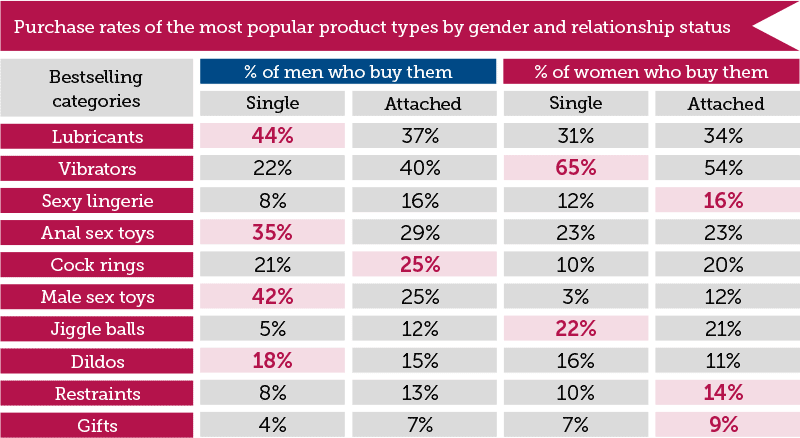
It’s always nice when results make logical sense. It’s even nicer when a few of them raise further juicy questions. Here’s what makes total sense:
• Single men buy male sex toys more often than attached men.
• Single women buy vibrators more often than women in relationships.
• Sexy lingerie is bought by attached men and women at the same rate, while single men buy it a lot less often.
So far, so good. Then we reach dildos and anal sex toys.
Women buy anal sex toys at the same rate regardless of their relationship status: 23%. But single men buy them more often than attached men: 35% versus 29%. Single men also buy dildos at a higher rate than any of the other three groups. But why?
We have to go deeper. Let’s focus on butt plugs and divide our men and women by their relationship status and sexual orientation.
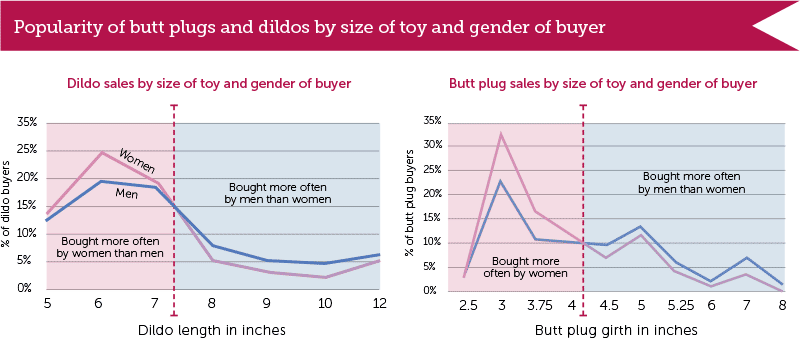
The demographic group that buys butt plugs at the lowest rate is single straight women. The group that buys them at the highest rate is single gay/bi men. But look at where single straight men rank: third, above attached straight men, and every female group. In fact, single straight men buy butt plugs at twice the rate of single straight women. And it’s statistically more likely that a straight man who buys a butt plug will be single than in a relationship.
Single straight men buy butt plugs at a higher rate than straight men in relationships and every female demographic group
Of course, nothing about buying and using a butt plug or dildo contradicts a person’s claim that they are straight. After all, these are inanimate objects made of silicone and rubber, not people. But they nevertheless have certain stereotypes attached to them, like ‘Men penetrate; women are penetrated,’ and ‘If a man puts something in his ass, he must be at least partly bisexual.’
These assumptions fly out of the window when you consider things like the Kinsey Scale, which describes sexual orientation as a continuum, not a dichotomy. Or when you read the research of neuroscientists Ogi Ogas and Sai Gaddam, who in their book A Billion Wicked Thoughts analysed 100 million people’s sexual fantasies through their web histories. Arguably their most surprising discovery was that straight men very much like looking at penises. In fact, they search for them almost as often as they search for vaginas. And straight men especially like big dicks.
Ogas postulated that this might be because of the penis’s role in our ancestral past. Penises have for millennia been used to indicate aggression, sexual interest, and mark territory, as well as function as a hard-wired cue for sexual arousal. In essence, if a prehistoric man saw another guy sporting an impressive erection, it probably meant he was about to have sex with some nearby nubile lady. This turned on the peeping Tom and motivated him to engage in sperm competition with the first guy by getting his own erection and having sex with the same female, who presumably would have felt quite spoiled by the sudden abundance of erections on offer.
Whether or not all that is true, I don’t know, but it got me thinking. If straight men supposedly like big cocks so much (or, at the very least, the concept of women being fucked by them), is this preference expressed through the dildos they buy? More specifically, do men buy bigger realistic dildos than women?
Matters of size
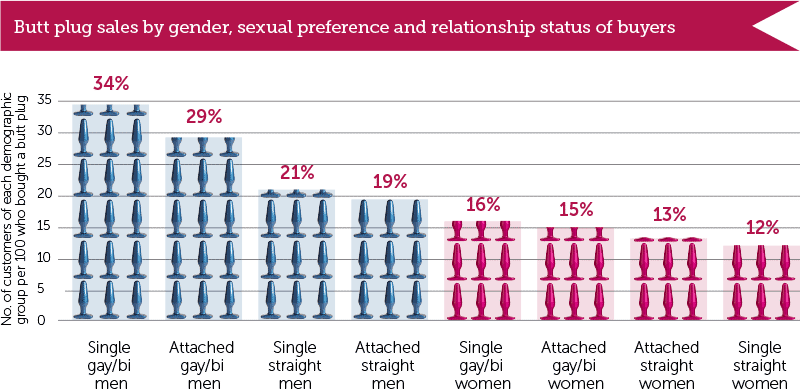
Men do in fact buy larger dildos at a higher rate than women. The graph on the left shows that dildos under 7.5 inches long are bought at a higher rate by women than men, whereas those over 7.5 are more popular with guys. This isn’t a function of sexual orientation, either.
35% of single straight men buy a realistic dildo that is 8 or more inches long (as do 35% of single gay men), compared to 30% of attached straight men, 25% of single straight women and 20% of attached straight women.
Men also buy large butt plugs at a much higher rate than women. Single straight guys are almost five times more likely than single straight women to buy a large butt plug and 76% more likely than attached straight men. Butt plugs with girths of 8 or more inches (which is as thick as a coke can) are bought by 1.8% of women who buy butt plugs, compared to 6.6% of men.
It seems that men like bigger dildos and butt plugs than women, regardless of their relationship status or sexual orientation. But if we’re talking about big, you ain’t seen nothing yet.
Behold the Daunting Dozen—Lovehoney’s twelve biggest toys. Only 1 in 600 customers buys one of toys above and it’s 6.5 times more likely that person will be a man than a woman. It’s hard to say for sure how the buyers of these toys break down demographically, because there aren’t many of them, but a sample of thirty sales showed that three-quarters were bought by straight guys. Correction: straight, ambitious guys.
It’s only when you read the reviews for these gargantuan toys that you begin to see that their buyers take enormous pride and pleasure in being able to train their bodies to accommodate them. Here’s an example review, written about Victor (the artillery shell dildo I mentioned earlier, sixth from the right above).
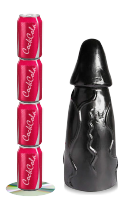 “If you want a feeling of complete fullness and then some this is the one for you. The first time I actually managed to get it inside of me was the best sensation ever.
“If you want a feeling of complete fullness and then some this is the one for you. The first time I actually managed to get it inside of me was the best sensation ever.
This is in no way for beginners or the fainthearted. It is something you cannot be prepared for. The pictures do it no justice, when you see it for the first time you literally have to scream.”
— Gay engaged male reviewer.
And he gave it ten out of ten. The average rating across all products is an impressively high 8 out of 10. I asked Lovehoney about this and they explained that if a particular product gets lots of poor reviews, they trust the community’s opinion and simply stop stocking it.
Let’s look at Lovehoney’s sex toy reviews in more detail. After all, they are the closest we can get to knowing how people feel about the products they buy. Plus, Lovehoney happens to have the largest collection of them in the world (currently 80,000).
The Language of Sex Toy Reviews
For every 100 words men write to review sex toys, women write 110. And for certain female-centric product types, they write considerably more on average than men who review the same items. Women write 46% more about bras, 50% more about lingerie and 53% more about erotic books. The type of product women use the most words to review compared to men is sexy plus size clothing (62% more).
There are only five categories out of forty that men review at greater lengths than women: male underwear, male sex toys, better sex for him, anal sex toys and better anal sex. They don’t write a lot more (+3% for anal sex toys and +7% for better anal sex), but they do on average write more.
Here are the top pros and cons given for sex toys in general, and specifically for butt plugs. Interestingly, men and women have exactly the same positive and negative things to say about each category of toy. Neither gender has its own unique considerations.
I used a piece of software called Linguistic Inquiry and Word Count (LIWC) to examine the type of language men and women use in their reviews of Lovehoney products. LIWC counts how many times a writer includes words in his or her text that correspond to 70 pre-defined language categories. For example, the First-person Singular category contains words like I, me and mine. The Tentative category has words like guess, maybe and perhaps. And the Anger category includes words like hate, terrible and awful. The theory is that by counting how many times people use certain categories of words in their writing, you can infer something meaningful about their feelings.
I found that men and women are extremely similar in how they use language to review adult products. Neither gender uses negative words much more often than the other, or negations, adverbs, pronouns, and so on. In fact, across 70 measures, there were only a few clear differences between the language men and women use in their reviews. One was that men use twice as men explicit words (like fuck and shit) than women. Another was that on average women use 40% more exclamation marks than men and the word love 64% more.
Men reference their female partners in sex toy reviews significantly more than vice versa.
But I think the most intriguing difference is how often men and women reference their partners in their reviews. I used LIWC to count how often men use the words she, her and hers, compared to how often women use he, him and his—men use them 90% more.
Next, I counted how often each gender uses the words we and our (e.g. ‘We hadn’t tried the four-stage rock dildo before, it was our first launch.’) Men use these words 70% more than women. To make sure that reviewers are in fact using these words to reference their partners, I re-ran the counts on reviews written only by single men and women. Single reviewers do indeed reference other people significantly less often than reviewers in relationships.
Finally, I compared only straight people in relationships (to remove gay men and women who mention their same-sex partners). Men still mention women 90% more than vice versa. This seems to be because toys that are mostly bought by women (like vibrators and ben wa balls) are still quite often bought by men, therefore men review them and mention their female partners. However, not many women buy and review male sex toys. It might also say something about which person in a relationship is more often the one buying sex toys and initiating their use in the bedroom.
***
Lovehoney’s 365-day free returns policy means that a customer can send any item back within a year, even if it’s been used, for a full refund. 5% of the 1 million items I analysed were sent back. Women return items more than men, but this is because they buy the majority of the clothing, which inevitably sometimes doesn’t fit (or feel sexy). Women are pickiest about catsuits—they send 1 in 3 back, compared to 2 in 10 by men. Clubwear clothes show the biggest difference in returns between men and women, with women being three times more likely to send them back.
The most returned type of male sex toy is realistic lifelike sex dolls (9.2%), followed by inflatable blow-up dolls (5%). The least returned male sex toy is the Fleshjack, which is sent back 3% of the time. And all of the above are returned a bit more often than the item that began this whole adventure: the bestselling Jessica Rabbit 2.0 vibrator. A minuscule 2.5% of men and women send it back. The rest keep it tucked away in their bedside drawers, which can—until next time—now be closed.
The Visuals
Below you can see the full infographic (and details from it). It summarizes the main results featured in the article above, plus lots more. I particularly recommend checking out the high resolution version of Sales by Gender of Buyers if you’re interested in how sales from various sub-categories are split between men and women.

Direct Links:
• Small — 1000px wide
• Medium — 1300px wide
• Large — 1500px wide
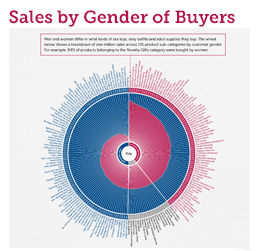 Direct Link:
Direct Link:
• Medium — 1000px wide
• Medium — 1600px wide
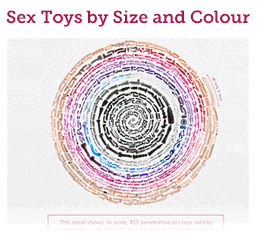
Direct Links:
• Small — 1000px wide
• Large — 1500px wide
• XXL — (Contact for higher res images)
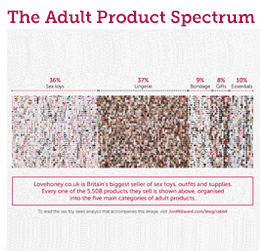 Direct Links:
Direct Links:
• Medium — 1000px wide
• Large — 2000px wide


